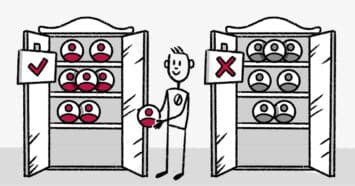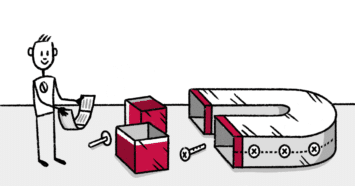Lead Nurturing: The Secret To SaaS Customer Acquisition

Need to improve lead quality and reduce customer acquisition costs (CAC) for your SaaS? Lead nurturing is a critical piece of the funnel—especially when you need more sales qualified leads (SQLs).
If you’re relying on that slick landing page or that catchy paid search campaign to convert leads, you’re probably missing out on a lot of valuable customers.
Forty-nine out of 50 website visitors, to be exact. The average SaaS search ad generates just 1 conversion for every 50 landing page visitors. So how can you improve those numbers?
In this article, you’ll discover why lead nurturing for SaaS is essential, which tools to add to your tech stack, and how to implement successful tactics right away.
What is lead nurturing?
Lead nurturing is the process of building relationships with prospects by creating a series of touchpoints. As you get to know prospects, you can deepen the connection, guide them through the buyer’s journey, and eventually direct qualified leads toward your solution. It’s a critical step of any SaaS marketing strategy.
You can certainly rely on a single channel to foster relationships. But most lead nurturing strategies include multiple marketing channels—ranging from email campaigns and content marketing to paid search and organic social.
If this sounds like it could be a lengthy process, that’s because it absolutely is. Successful lead nurturing requires a long game, as it’s essentially a never-ending job.
How long? In AdEspresso’s case, for example, some leads purchased a subscription more than a year after joining the email list and receiving a steady stream of high-value content—like the webinar invitation below.

Fortunately, automation tools can streamline your workflow and save you tons of time. And the more data you gather, the more you can fine-tune each touchpoint.
But it’s important to note that lead nurturing isn’t a never-ending sales pitch.
The most effective lead nurturing flows include educational content with light product placement. They focus more on providing value and less on driving direct sales.
Why lead nurturing strategies are crucial for SaaS
Wondering if lead nurturing is really worth the resource investment? Here’s how a smart strategy can pay off for your SaaS:
Reduces CAC
If you already have a strong lead generation system, it’s easy to assume that a lead nurture program isn’t necessary. Leads will convert when they’re ready, right?
Not necessarily. In most cases, the vast majority of prospects aren’t ready to buy when they first engage with your product or business.
If you fail to follow up, you could lose the lead completely. That means you could also waste the amount you already invested in producing the lead magnet or paying for the paid search click.
Do that for long enough, and your CAC could skyrocket.
Instead, take the time to nurture leads to get more out of your initial investment. The better your lead nurture sequence converts, the more you can reduce CAC over time.
Improves lead qualification
Not every prospect who enters your SaaS funnel will fit your ideal customer profile (ICP) or ever come close to converting. But you can’t always know that at the first touchpoint.
So how can you avoid handing off every lead to your sales team—and wasting their valuable time and skills in the process?
With a lead nurture sequence, you can get to know prospects better. Every time they click to view an asset or download a lead magnet, you can ask them qualifying questions.
Take a look at this example from HubSpot. The email highlights a new report with original data and expert insights. That sounds super valuable.

Leads who click through can download the report at no cost. All they have to do is answer a few questions—like company size—to help HubSpot determine if they fit the ICP.
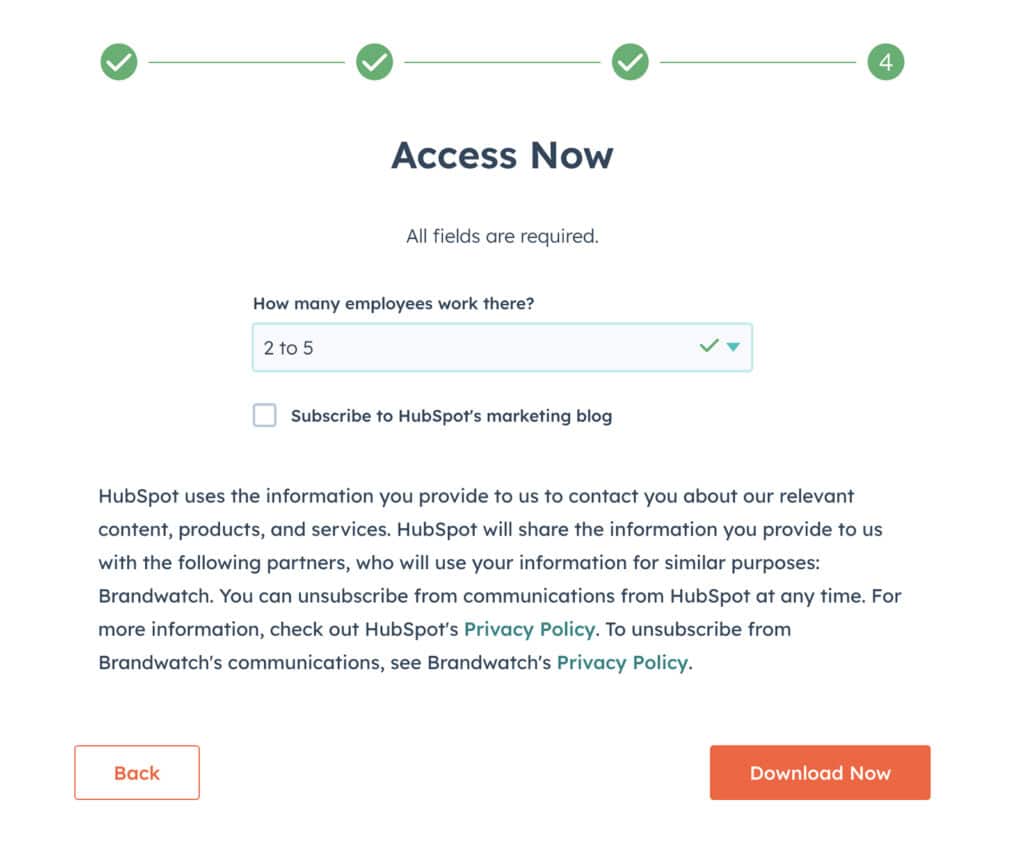
Using data similar to the example above, you can build out their profiles in your customer relationship management (CRM) tool.
Some prospects may never progress past the information qualified lead (IQL) stage. But when some do become SQLs, you can confidently (and automatically) hand them off to sales.
Builds trust
SaaS sales cycles can be notoriously lengthy, averaging nearly 90 days. From initial touchpoint to conversion, you can bet that your prospects are actively considering other options—including your competitors.
So how can you encourage them to do business with you instead? A lead nurturing sequence is an ideal opportunity to provide value and establish credibility.
First, understand the needs, challenges, and goals of your ICP. Then show prospects how and why your product is exactly what they need—and why they should trust your SaaS.
Lists of features and statistics can certainly help. But social proof, case studies, customer stories, and lead magnets tend to be much more effective for building trust and establishing authority in your niche.
Increases AOV
Some prospects may eventually convert even without consistent follow-ups. But those who do receive your lead nurturing sequence are likely to convert with a higher average order value (AOV).
In fact, nurtured leads spend nearly 50% more than those who don’t receive your automated follow-up sequences. Why? The trust you’ve built and the value you’ve shared might have something to do with it.
Creating and testing a successful nurture sequence certainly requires time and money. But when it results in increased AOV and reduced CAC, the math makes a lot more sense.
How does a lead nurturing sequence work?
The specifics of your sequences will depend on factors like your niche, your ICP, and your channels. Here’s an example workflow you can use as a starting point to create your own:
1. Collect contact details
Before you can start nurturing leads, you need to add them to your sales funnel. Use channels like paid search, paid social, or organic social to attract new prospects and generate leads.
The easiest way to collect prospects’ contact information and get them to opt into your marketing is to offer them something of value. Lead magnets like checklists, ultimate guides, ebooks, and webinars often work well.
When you collect prospects’ contact details, ask them a few questions about themselves. Then use their answers to create segments and nurture prospects more effectively.
2. Launch an automated sequence
Once prospects have opted in to hear from your business, add them to an automated nurture sequence. Then you can follow up by sending targeted content at preset times.
That doesn’t mean you should simply add these prospects to your newsletter list. Sending untargeted content that’s designed for current customers won’t get you anywhere.
Instead, add potential customers to a drip campaign that’s engineered for their role, use case, or niche. Provide value every step of the way by sharing content that answers common questions, educates about product benefits, or details relevant customer stories.
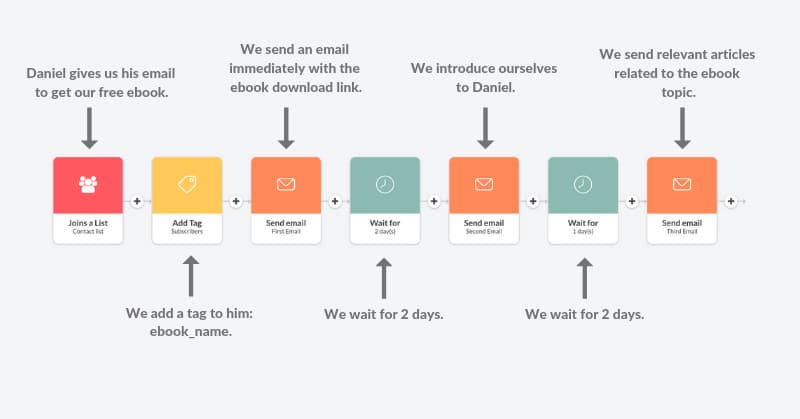
Source: Automizy
Take the automated sequence above, for example. This Automizy drip campaign starts with a lead magnet and includes several touchpoints designed to improve brand awareness and deliver relevant resources.
3. Connect across channels
For many SaaS companies, automated emails are the foundation of a successful lead nurturing sequence. But email isn’t the only channel your workflow should use.
The more channels you include in your lead nurturing sequence, the more retargeting opportunities you can create. To get prospects to follow your Twitter account, subscribe to your YouTube channel, or follow your Facebook page, use specific calls-to-action (CTAs).
Then create middle-of-funnel organic content to nurture these prospects outside of your email campaigns. You can also use paid social to retarget specific segments with lead magnets designed to guide prospects further along in the buyer’s journey.
How to know if your lead nurture sequence is working
What does a successful lead nurture sequence look like? And how can you tell if yours is on track? Set key performance indicators (KPIs) for these metrics and measure progress:
- Engagement rate: Measure engagement for the entire sequence and for each touchpoint. Are some ads, emails, or social media posts generating nearly zero engagement? Update them with a new test version or remove them altogether.
- Conversion rate: Track conversions for each nurture sequence, including when and where they happen. Do some channels convert better than others? Do some segments convert faster than others? Use the data to optimize your approach.
As you track performance for each workflow, keep the following SaaS metrics in mind. They can confirm that your sequence is working:
- CAC: Is your CAC going down? Which segment or sequence has the lowest CAC?
- AOV: Is your AOV going up? Which segment or touchpoint has the highest AOV?
Top tools to streamline lead nurturing for SaaS
With the right tools, you can optimize your nurture sequences and your sales reps’ workflow. Integrate these tools into your tech stack:
CRM
A crucial tool for any sales and marketing team, a CRM is essential for keeping track of prospects. With a CRM like HubSpot, you can create and build out profiles for each user as they go from prospect to marketing qualified lead (MQL) to SQL to customer.
For best results, plan for your data to evolve continuously. Update profiles automatically to reflect prospects’ behaviors and their responses to your lead qualification questions.
That way you can use progressive profiling to refine user-profiles and segment effectively. Below, we’ll cover how you can use this data to provide personalized experiences.
Marketing automation platform
A marketing automation platform is critical for an efficient, optimized lead nurture sequence—especially if you plan to connect via email. With the right platform, you can map out touchpoints and build a workflow that fits your buyer’s journey.
As you segment prospects, you can add them to relevant sequences and start fostering relationships with a single click. Using built-in analytics, you can track results and make modifications to improve outcomes.
Make sure to choose an automation platform that integrates with your CRM. That way you can maintain data integrity and streamline cross-channel retargeting.
Search and social ads platform
An ad management platform can also improve your workflow, especially if you use one that advertises across multiple channels while integrating with your CRM.
As an example, AdEspresso supports Facebook and Google ads, allowing you to split-test ads and pinpoint exactly what’s working—and what isn’t. With that data, you can retarget prospects and scale ads across channels.
8 Lead nurturing tactics that work
With these tried-and-tested tactics, you can build a solid lead nurturing strategy that delivers maximum value:
1. Map the buyer’s journey
There’s no need to guess how your nurture sequence should work or create it from scratch. Instead, use your buyer’s journey as a guide.
Use your CRM data to track the steps a typical prospect takes before converting. Then recreate those touchpoints in a marketing automation, providing value at every stage.
2. Use audience segmentation
Does your SaaS have more than one buyer’s journey? Have you noticed that some prospects respond differently to your drip campaign?
Use your automation platform to separate prospects into similar segments. For example, you might segment based on activity, intent, use case, or role. Then create unique workflows that are more likely to resonate with each audience group.
3. Leverage lead scoring
Not every prospect will fit your ICP. Those who don’t shouldn’t enter your lead nurture sequence. With a lead scoring tool, you can prevent unqualified leads from starting your automation and add them when they’re a good fit.
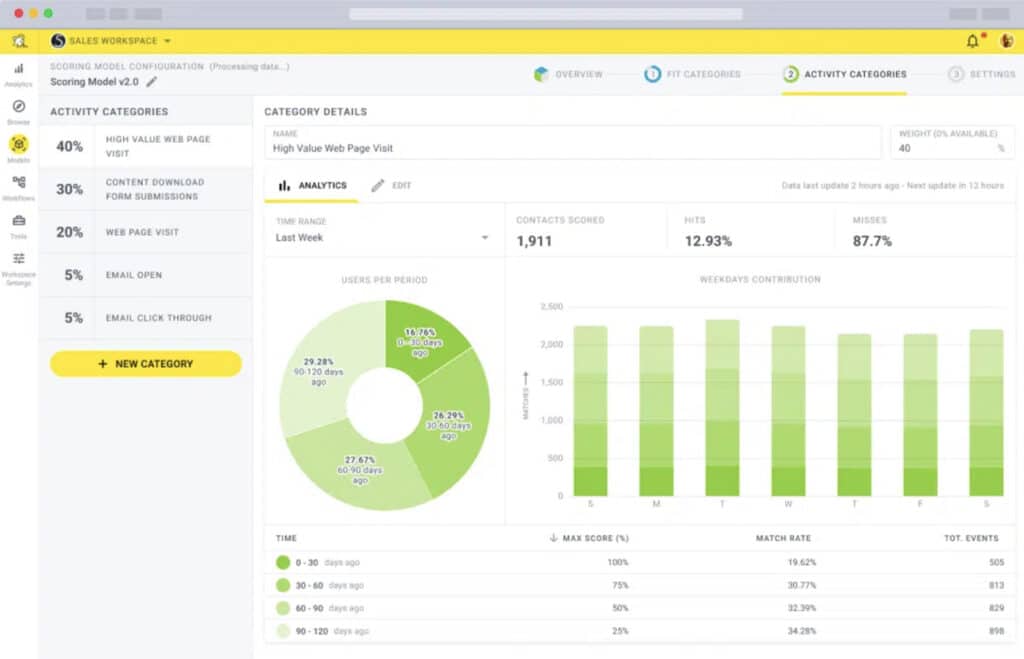
With a tool like Breadcrumbs, you can create and test scoring models to score leads on various activity and intent signals. Since it considers cross-channel data, Breadcrumbs can provide a complete picture of each opportunity—so you can nurture the right leads at the right time.
4. Personalize outreach
The better you get at lead scoring and audience segmentation, the easier it becomes to personalize your outreach and make your lead nurturing campaigns more effective.
When you’re serious about creating value for leads, go beyond personalization basics like using first names in emails. Use the data you’ve collected to address relevant goals, challenges, and pain points with well-aligned assets.
5. Use specific CTAs
Do your CTAs sound like a broken record? Instead of prompting leads to “book a call” after every single touchpoint, create unique CTAs that align with the buyer’s journey.
Here are a few CTAs to consider:
- Get the answer here
- Find out how [customer] solved this problem
- Ask us anything
- See how we compare to [competitor]
6. Get the timing right
For some audience segments, emailing daily or capping ad frequency at 3x per week might be the optimal pace. For others, that frequency may be overwhelming and off-putting.
Test your lead nurture sequences continuously so you can get the timing right for each segment. Getting a lot of negative feedback? Don’t wait to address obvious issues. Adjust the timing or rethink the cadence so you can start improving results right away.
7. Know when to stop
Not every touchpoint will deliver the results you expect. If you find that some ads, emails, social posts, or lead magnets aren’t moving prospects forward in the buyer’s journey, don’t hesitate to eliminate them altogether.
As MobileMonkey CEO and founder Larry Kim explains, knowing when to stop can have a huge long-term impact on your lead nurture sequence.
“If we notice that there were no signs of life in two consecutive emails, we just remove that email from the sequence. That will reduce your complaint rate and improve your deliverability. Send more emails to your engagers and less (or no emails) to your non-engagers. You’d be surprised at how many marketers do that completely backwards!”
Final thoughts on lead nurturing strategies for SaaS
For SaaS, lead nurturing is essential, especially given the low first-time visitor conversion rates and lengthy sales cycles. With the techniques above, you can build a nurture workflow that fits your ICP and aligns with your buyer’s journey—so you can convert more leads, make customer acquisition more cost-effective, and boost average order value.

